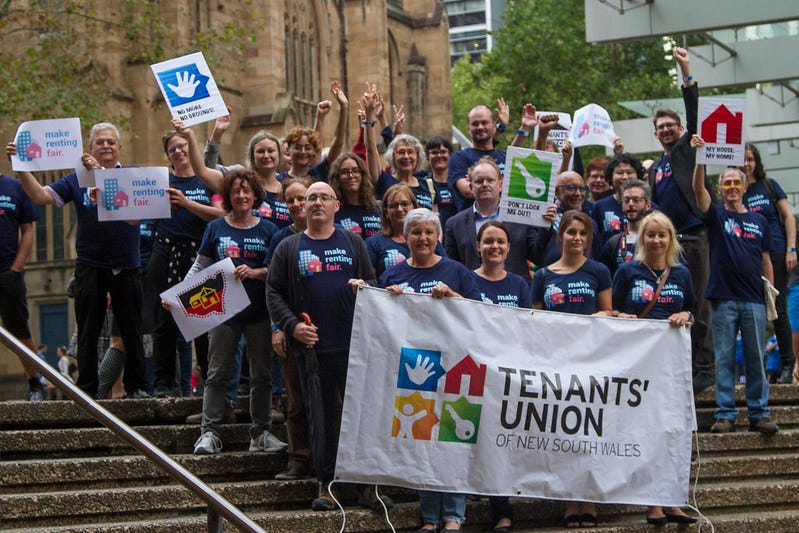Prefigurative Community Building (Part 15)
Tenant Unions - Organizing Power With for Housing Justice

The housing crisis is no longer a looming threat, it is a daily reality for millions. Across the globe, rents are skyrocketing, homeownership is increasingly out of reach, and growing numbers of people are pushed into housing precarity or outright homelessness. This crisis is not a failure of scarcity, but a crisis of coordination. It is not just that housing is expensive, it is that the systems that govern it are structured by Power Over: absentee landlords, speculative markets, and bureaucratic institutions that enforce exclusion.
In this context, tenant unions offer a model of Power With: collective action rooted in shared experience, mutual support, and solidarity. Tenant unions are not service providers or charity projects. They are networks of neighbors who organize together to confront unjust conditions, demand their rights, and create a foundation for long-term housing security and community resilience.
Tenant unions reject the idea that people must navigate their housing struggles alone. Instead, they build shared strength by coordinating without domination, distributing power laterally, and forming relationships that can resist exploitation from landlords, developers, and governments alike.
How to Start a Tenant Union
A step-by-step guide for horizontal organizing
1. Start with conversations
Begin with your neighbors. Host informal conversations in common spaces, hallways, parks, or over tea. Ask open questions like: “Are you dealing with rent hikes?” “Has your landlord neglected repairs?” “Do you feel safe and secure in your housing?” These stories form the basis for collective analysis and shared purpose.
2. Identify shared concerns
Once several people have expressed interest, organize a small meeting to map out shared issues. Be specific and concrete. Focus on what you can address collectively, unmet maintenance, harassment, evictions, unsafe living conditions, unfair rent increases. Don’t try to solve everything at once.
3. Create a working group
This core team becomes the seed of the union. Rotate responsibilities and emphasize transparency in all decisions. Choose a name together. Set a regular meeting schedule. Use consensus or modified consensus processes to ensure all voices are included.
4. Build your base
Knock on doors, flyer the neighborhood, and talk to people face to face. Invite renters in your building, your block, or your complex to join. Make it clear that the union is for tenants, by tenants, not for profit, not affiliated with any landlord or developer, and not beholden to political parties.
5. Take collective action
Start with a winnable campaign: a petition to demand repairs, a group letter challenging illegal fees, a protest at a landlord’s office. Celebrate small wins. They build trust, visibility, and collective confidence. Always act together, not alone.
6. Connect to the wider movement
Reach out to other tenant unions, housing justice groups, and legal support networks. Attend trainings, share strategies, and show up for each other’s fights. Solidarity strengthens the movement, and tenant power grows when local struggles become coordinated regional networks.
Avoiding Power Over
Principles for horizontal coordination
Shared leadership: Avoid hierarchy. Use facilitation and consensus structures that allow all participants to shape decisions.
Accountability through transparency: Make sure everyone can access meeting notes, decisions, and finances.
Mutual aid, not charity: Do not position your union as “helping” others. Work from a foundation of solidarity.
Protect against co-optation: Be cautious about engagement with NGOs, nonprofits, or city councils. Accept support without ceding autonomy.
Center the most impacted: Include tenants facing eviction, harassment, or homelessness in every level of organizing. Their voices must lead.
Resources to Get Started
Tenants Together — Organizing guides, templates, and support for union formation
Home Line - Forming a Tenant Association — Practical tips and legal framing
Metropolitan Council on Housing — A New York-based housing justice network with toolkits
Los Angeles Tenants Union — An open, horizontal network with guides and organizing principles
Real-World Examples
1. Los Angeles Tenants Union (LATU)
LATU is a volunteer-led, horizontally organized union of autonomous locals across the city. It organizes renters to fight against eviction, rent hikes, and slum conditions. Their emphasis on tenant-led action and non-hierarchical structure makes them a flagship Power With organization. https://latenantsunion.org/en/
2. Crown Heights Tenant Union (CHTU)
CHTU in Brooklyn, NY, organizes multi-building campaigns, negotiates collective bargaining agreements, and trains new tenant organizers. They have successfully resisted landlord harassment and formed a powerful counterforce to gentrification.
https://crownheightstenantunion.org/
Housing as a Site of Resistance
Housing is not just shelter, it is the stage on which people live their lives. When housing is commodified, so too is safety, rest, dignity, and stability. Tenant unions resist this commodification by reasserting housing as a collective right. They prefigure a future where no one is evicted into the street, where no home is treated as an asset to flip, and where housing is governed by the people who live in it.
When neighbors come together, not in service to an institution, but in solidarity with each other, they begin to reweave the fabric of trust. That trust becomes the foundation for resistance. And that resistance, when coordinated across homes, neighborhoods, and cities, becomes a force that can unravel the very structures of Power Over that created the crisis in the first place.
Power With begins on your block. It begins with a knock on your neighbor’s door. It begins with a union.



